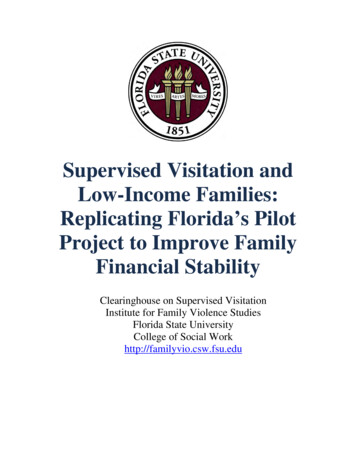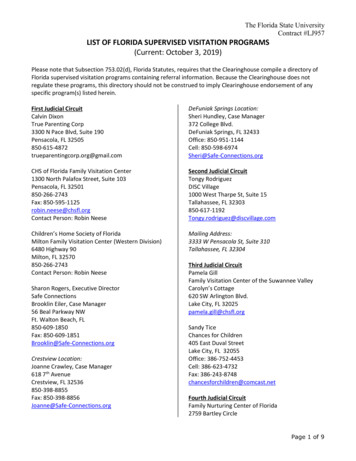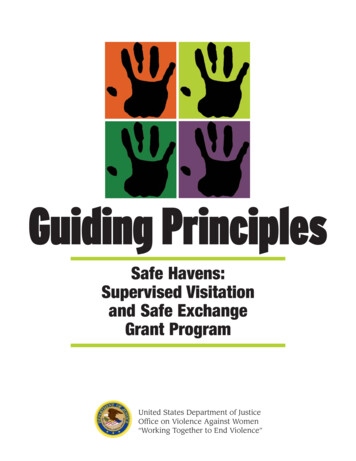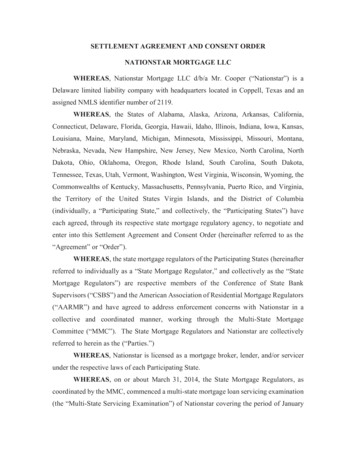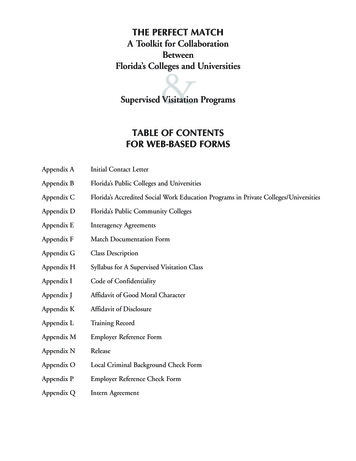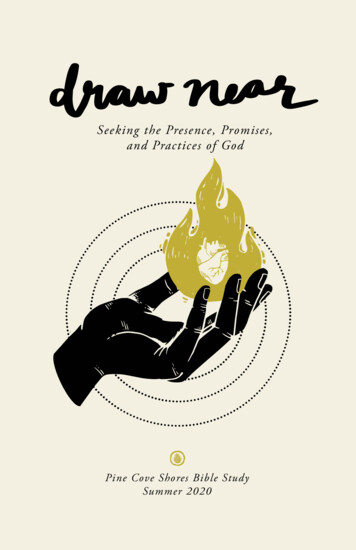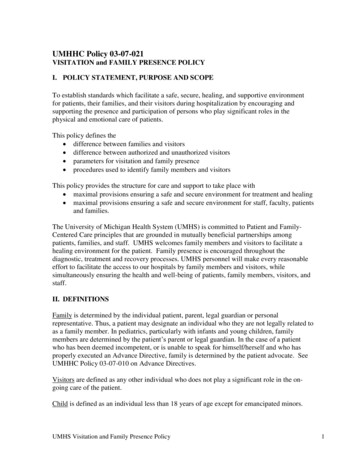
Transcription
UMHHC Policy 03-07-021VISITATION and FAMILY PRESENCE POLICYI. POLICY STATEMENT, PURPOSE AND SCOPETo establish standards which facilitate a safe, secure, healing, and supportive environmentfor patients, their families, and their visitors during hospitalization by encouraging andsupporting the presence and participation of persons who play significant roles in thephysical and emotional care of patients.This policy defines the difference between families and visitors difference between authorized and unauthorized visitors parameters for visitation and family presence procedures used to identify family members and visitorsThis policy provides the structure for care and support to take place with maximal provisions ensuring a safe and secure environment for treatment and healing maximal provisions ensuring a safe and secure environment for staff, faculty, patientsand families.The University of Michigan Health System (UMHS) is committed to Patient and FamilyCentered Care principles that are grounded in mutually beneficial partnerships amongpatients, families, and staff. UMHS welcomes family members and visitors to facilitate ahealing environment for the patient. Family presence is encouraged throughout thediagnostic, treatment and recovery processes. UMHS personnel will make every reasonableeffort to facilitate the access to our hospitals by family members and visitors, whilesimultaneously ensuring the health and well-being of patients, family members, visitors, andstaff.II. DEFINITIONSFamily is determined by the individual patient, parent, legal guardian or personalrepresentative. Thus, a patient may designate an individual who they are not legally related toas a family member. In pediatrics, particularly with infants and young children, familymembers are determined by the patient’s parent or legal guardian. In the case of a patientwho has been deemed incompetent, or is unable to speak for himself/herself and who hasproperly executed an Advance Directive, family is determined by the patient advocate. SeeUMHHC Policy 03-07-010 on Advance Directives.Visitors are defined as any other individual who does not play a significant role in the ongoing care of the patient.Child is defined as an individual less than 18 years of age except for emancipated minors.UMHS Visitation and Family Presence Policy1
Universal Wait Spaces: Public areas where family members and visitors from multiple unitscongregate to wait. These areas and rooms provide a resource for extended families andvisitors who need to remain close to the patient after visiting hours due to the patient’smedical condition or other extenuating circumstances. It is important that these roomsprovide a quiet and restful place after visiting hours for these families and visitors.Patient & Family Centered Care (PFCC): An approach to the planning, delivery, andevaluation of health care that is grounded in mutually beneficial partnerships among patients,families, and health care providers. PFCC applies to patients of all ages and may bepracticed in any health care setting.Mott Children’s and Von Voigtlander Women’s Hospitals Guest Services Specialist:(formerly known as Security Screeners) hospital personnel who work at security welcomedesks performing the following functions: greeting patients, family, visitors, staff andvolunteers; coordinate and manage visitation restrictions; assisting with parking informationand validation, way-finding, infection control screening, identification and badging; andproviding overall customer service.C.S.C.S. Mott Children’s and Von Voigtlander Women’s Hospitals Security Welcome Desk:Workstations located at all entrances—2nd floor Main, 2nd floor Taubman connector, 3rd floorfrom parking connector, Emergency Department, and all inpatient units (floors 7-12)—thatserve as reception and information desks for families/visitors entering Children’s andWomen’s. These desks issue ID badges as well as offer parking validation and infectioncontrol screening for those wishing to enter patient care areas. Desks are staffed seven daysa week.Restricted Visitor: Visitors or family members who are denied visitation because of legal,safety, security (e.g., parents denied visitation by Child Protective Services, non-custodialparent who has threatened abduction or harm, etc.) or communicable disease, or because theperson is denied visitation by the patient/family/guardian.III. POLICY STANDARDS, PROCEDURES/ACTIONSFOR FAMILY PRESENCEAND OTHER VISITORSA. Family Presence1. At least one adult family member will be welcomed at the patient’s bedside 24hours a day, 7 days a week to promote communication, to meet the cognitive andemotional needs of the patient and family, and to enhance the family caregiver’sknowledge and skill (Dougherty, 2010; Lam & Beaulieu, 2004; Verhaeghe,Defloor, Van Zuuren, Duijnstee, & Grypdonck, 2005).a. The number of family members per patient is dependent on the patient,family, or guardian’s request (Kirchhoff & Faas, 2007), the patient’s medical,emotional and psychological needs, the level of unit activity, and availablespace.UMHS Visitation and Family Presence Policy2
b. Patient/family/guardian-designated family members may be present at thebedside during procedures based upon the wishes of the patient and family.c. To ensure the safety of pediatric patients, family members are required toobtain and wear a badge identifying themselves.i. Badges are issued at C.S. Mott Children’s and Von VoigtlanderWomen’s Hospitals Security Welcome Desks.ii. Badges should be turned in when the patient is discharged. Theinpatient unit is responsible for instructing the primary supportperson(s) to turn in their IDs at the Security Welcome Desk upon thedischarge of the patient.d. To ensure patient and family safety and to provide high quality patient care,there are times when it is not possible for family to be present with the patient.An example of such a time is a surgical operation or at designated times onsecure inpatient psychiatry units.e. Inpatient Psychiatry Units: Please see Policy #02-004-0009 – PsychiatricInpatient Access to Mail, Visitation and Telephones for the inpatientpsychiatry unit’s visiting policy 004/02-0040009%20Pt.%20Access%20to%20TMV.11.pdf2. As needed, nursing, social work and/or security will work with the family to assistwith accommodating large families and/or groups in universal wait spaces.a. The house manager can be engaged in this process.3. As soon as possible, the patient/family/guardian will complete the appropriatedocument designating family and friends.a. For a patient in C.S. Mott Children’s Hospital or the Von VoigtlanderWomen’s Hospital, a Patient/Parent Choice Form should be taken to one ofthe Security Welcome Desks where an appropriate badge will be issued (SeeExhibit 1).i. Security should be notified of all visitor restrictions and changes incustodial status that develop by calling the Facility Control Center at936-7890 who will update the Visitor Restriction Spreadsheet andnotify Guest Services Specialists at a Security Welcome Desk.b. For a patient in University Hospital, Cardiovascular Center, a Family andFriends List for Current Inpatient Admission should be obtained. (See erThanConsents/Institutional/700011 dfc. For a patient in the ambulatory care setting, a Family and Friends List forOutpatient Clinics should be obtained. (See Exhibit onsents/Institutional/7010010 FamilyAndFriendsListForOutpatientClinicsOnly.pdfd. For information about sharing patient information, please refer to UMHSPolicy 04-04-312 – Disclosures to Family and Friends of -04-312.htmUMHS Visitation and Family Presence Policy3
4. Patient/family/guardian-designated family members are welcome to participate inpatient-family centered medical rounds and nursing rounds and other careconferences that relate to the plan of care for the patient.5.For guidelines on sharing a bed with a patient, please refer to PediatricParent/Child Bed Sharing Policy for more ric/pdfs/Bed%20Sharing%20Guidelines.pdf.B. Visitors1. Visitors are welcome during the regular visitation hours of 9am to 9pm.Exceptions to these hours are granted on a case-by-case basis by the patient’s careteam in collaboration with the patient/family/guardian.a. To ensure the safety of pediatric patients, visitors are required to obtain andwear a badge identifying themselves.i. Badges are issued at C.S. Mott Children’s and Von VoigtlanderWomen’s Hospitals Security Welcome Desks.2. The number of visitors per patient is dependent on the patient, family orguardian’s request (Kirchhoff & Faas, 2007), the patient’s medical, emotional andpsychological needs, the level of unit activity, and available space.3. Hours for visitors will also be adhered to in the Universal Wait Spaces andconsultation rooms located in UMHS. Security officers and/or Guest ServicesSpecialists will perform a check of these areas as soon as possible following theend of visiting hours and frequently during the night to ensure rules governingusage, noise, lights and TV are being adhered to. If issues of overcrowding ornoncompliance with usage expectations arise, these issues will be resolved jointlyby the unit staff, Social Worker, Community Relations and Security Services.4. Visitors may be asked to leave the patient’s bedside during medical rounds,nursing shift change, care provision, and resuscitation events unless the patient orfamily indicates they would like the visitor to stay.C. Children (Family and Visitors)1. Children may visit during regular visiting hours (9am-9pm).a. Children are allowed to visit family members in the intensive care setting topromote coping for the child (C. Clarke & Harrison, 2001; C. M. Clarke,2000) and promote normalcy for the patient/family (C. Clarke & Harrison,2001; Verhaeghe et al., 2005).UMHS Visitation and Family Presence Policy4
2. The length of the visit will be determined by the chronological and developmentalage of the child, the condition of the patient and the patient/family/guardian’swishes, as well as the unit's activities (Kean, 2010; Kirchhoff & Faas, 2007).3. All visiting children must remain under the supervision of an adult (other than thepatient and the healthcare team). Parents, guardians, or other supervising adultare responsible for the behavior of visiting children at all times.a. Older children (e.g., older teens) may be independently present at the bedsideof a patient when requested by the patient/parent/guardian.b. During labor and delivery, this adult must be someone other than mom’sprimary support person.4. Thought should be given to preparing the child for the visit, especially in theintensive care unit (C. Clarke & Harrison, 2001; C. M. Clarke, 2000; Kean, 2010).Members of the health care team (e.g. social worker, child life specialist, nurse)are available to assist in preparing children for visiting the hospital.Developmentally appropriate reference tools are available to aid in preparation(See Exhibit 3).5. Children are not generally permitted to spend the night unless there are specialcircumstances that would be in the best interests of the patient and/or child (e.g.end of life, trauma, special life events, etc.). This is a collaborative decision withthe healthcare team and patient/family.a. When a nursing mother is a patient (in an area outside of obstetrics) the infantmay stay in the room but another adult must also be present. The patient isrequired to complete a form that acknowledges their responsibilities to ensureappropriate care for the infant. The form can be found umentation/Forms/Womens/35-10004 re.pdf.b. When primary caregiver of a patient is a mother who is the sole source ofnutrition for another child, the nursing infant can remain with the mother.D. Cultural Considerations1. The patient’s cultural and religious beliefs will be honored while providing carefor the patient and family to the extent possible.a. The Office of Decedent Affairs (ODA) is available to assist with informationand resources addressing customs and practices of various cultures andreligious groups. ODA may be contacted at: 734-232-4919 or online tmb. Interpreter Services may also be a resource for language translation as well asaddressing cultural diversity. Interpreters may be reached at 734-936-7021 oronline at: .htmc. Spiritual Care is available to provide consultation and support for all religiousand spiritual care needs. Spiritual Care may be reached at 734-936-4041 orUMHS Visitation and Family Presence Policy5
online at: http://www.uofmhealth.org/patient and visitor guide/counselingspiritual2.Staff is encouraged to have direct conversations with patients/family membersregarding individual cultural and religious needs, requests and accommodations.If a request cannot be specifically accommodated for safety reasons, every effortshould be made to help the patient and family understand the reason and need formodification, and to identify satisfactory alternatives.E. End of Life Considerations1. Access to the patient at the end of life will be unlimited to enhance emotionalwell-being and coping for family members (Kirchhoff & Faas, 2007).a. Additional resources are available at C.S. Mott Children’s and VonVoigtlander Women’s Hospitals to help family members rapidly return to thebedside when unexpected end of life situations occur. Unit staff should notifyGuest Services Specialists front desk at 763-4120 as soon as possible to helpexpedite the family’s entrance to the hospital.2. Information and resources for when a loved one has died, and assisting childrenwith death and grief may be found on the website of the Office of DecedentAffairs (ODA) at: http://www.med.umich.edu/socialwork/index.htmF. Family Presence during Resuscitation/Codes1. Family members may choose to remain with the patient- at, or near the bedside,during resuscitation efforts providing that resuscitative efforts can be carried outappropriately (AACN Practice Department Editors & Cox, 2007; Kosowan &Jensen, 2011; Sanford, Pugh, & Warren, 2002).2. A staff member will be identified to educate, assist, coordinate and support thefamily member surrounding their desired level of participation while ensuring thesafety of patient, family, and staff.a. Social work is available to provide support and assistance during these times.b. Social work is an active member of the hospital emergency response team (i.e.code team). Their primary role is to assist the family during the code. Socialwork may act as the liaison between the medical team and family to insurethat family is informed and their wishes honored as possible.c. Family members may decide to not be present during a resuscitative, in whichcase, they should be walked to a safe, private space by staff. They should bekept informed of the patient’s status.G. Family and Visitor RestrictionsUMHS Visitation and Family Presence Policy6
1. The patient/family/guardian has the right to define who the patient’s family isas well as the right to designate a person as a restricted visitor as they desire.See UMHHC Policy 06-01-001 Patient Rights and Responsibilities formore detail.2. Visitors and/or family members may be denied hospital entry in the event of legal,safety, security, and/or communicable disease concerns.a. Family member presence and/or visitation may be restricted when individualsare unable to meet behavioral expectations (see “Expectations for Familiesand Visitors” section found below).3. To ensure patient confidentiality, there may be times when families and visitorsare asked to vacate an area.4. If it becomes necessary to restrict visitation or family presence, a collaborativeapproach between family and staff will be undertaken to establish guidelines.H. Expectations for Families and Visitors1. Family members and visitors should not possess signs/symptoms of acommunicable disease (e.g. fever, cough, sore throat, etc.) when visiting apatient.a. When staff observes that families and/or visitors are displaying symptomsof a communicable disease, staff should address the issue with thefamily/visitor to ensure patient and staff safety/health and may require thefamily member or visitor to leave the premises.2. Family members and visitors are expected to treat patients, visitors, and staffat UMHS with respect. Violent, threatening, and/or disruptive behaviors willnot be tolerated.a. When staff encounter violent and/or threatening behaviors they willfollow: UMHHC Policy 04-06-038 Handling Violence in the Workplaceor UMHHC Policy 62-10-004: Management of Threatening or ViolentBehavior by Admitted Patients or Families.3. Family and visitors should only enter the patient’s room that they are visiting.Patients/families/guardians should notify healthcare staff when they have anundesired visitor.a. In C.S. Mott Children’s and Von Voigtlander Women’s Hospitals, the IDbadge designates they have been screened.I. Semi-Private Room Considerations1. Patients may stay in semi-private rooms, which may require additional sensitivityto respect the privacy of the other patient, the patient’s family members, and /orvisitors.UMHS Visitation and Family Presence Policy7
a. Family members and/or visitors may be asked to leave a patient’s room whenthe patient’s roommate requires care, sensitive discussion, or other times asdesignated by health care staff.b. Family members may be offered a place to sleep other than the patient’sbedside (e.g. lounge) when there is a roommate present.c. Family members and visitors should be sensitive to the volume of theirconversations and try to maintain a low level of noise.i. During the night time (after 9p), family members may be asked tosilence their phones and pagers or have phone conversations in adifferent location so that sleep disturbance is minimized.2. The presence of families and visitors of patients being housed in bay-like areas(e.g., PICU, PCTU, NICU, PACU), may also be influenced by care beingprovided to other patients (e.g., resuscitation efforts, etc.).J. Infection Control Expectations for Families and Visitors1. All persons must wash their hands thoroughly or use an alcohol based hand rubupon entering and exiting a patient room/area.2. In the setting of a community-wide increase/outbreak of a communicable diseaseUMHS reserves the right to perform health screenings on all family/visitorsand/or place additional restrictions on visitation to limit exposure tocommunicable diseases.3. Health screenings may be performed at any time in accordance with the InfectionControl Screening Policy for Family and Visitors (See Exhibit 4).a. Health screenings will be performed by staff at the Security Screening Desksfor the C.S. Mott Children’s Hospital or the Von Voigtlander Women’sCenter.i. If the answer to any of the Health Screening questions is “yes”, theindividual may not go onto the inpatient floor. Any child not passingthe health screen must be taken home or remain in non-patient careareas with a responsible adult.4. In general, visitation is not restricted for patients in precautions (e.g. contact,protective, etc.). Visitors are required to follow the appropriate infection controlpolicies. Information on restrictions and the use of personal protective equipmentwhen visiting a patient in precautions can be found in UMHS Infection Controlpolicies.a. Contact e/ICM ip/contact.htmb. Droplet e/ICM ip/droplet.htmUMHS Visitation and Family Presence Policy8
c. Respiratory ICM ip/ri.htmd. Protective e/ICM ip/protect.htm5. Education for family and visitors can be found on the:a. Infection Control website: http://www.med.umich.edu/i/ice/ptedu.htm.b. Patient Education ented/search by topicIV.EXHIBITSExhibit 1 - C.S. Mott Children’s and Von Voigtlander Women’s Hospitals VisitingPlan FormExhibit 2 - Family and Friends List for Current Inpatient AdmissionExhibit 3 – Family and Friends List for Outpatient Clinics OnlyExhibit 4 - Table of Developmental ConsiderationsExhibit 5 - Infection Control Screening QuestionsUMHS Visitation and Family Presence Policy9
Exhibit 1 – C.S. Mott Children’s and Von Voightlander Women’s Hospitals Visiting PlanFormUMHS Visitation and Family Presence Policy10
Exhibit 2 – Family and Friends List for Current Inpatient AdmissionUMHS Visitation and Family Presence Policy11
Exhibit 3UMHS Visitation and Family Presence Policy12
Exhibit 4Table of Developmental ConsiderationsAgeDevelopmental StageInfants andToddlers(0-3)Trust vs. Mistrust(Erikson), (McCue, K.,Bonn, R., 1996)Autonomy vs. shameand Doubt (Erikson),(McCue, K., Bonn, R.,1996) and Sensorimotorand Preoperational(Piaget) (C. Clarke &Harrison, 2001; McCue,K., Bonn, R., 1996)Preschool(3-6)Understanding About Illnessand DeathSenses separation and mayexperience anxiety. Unableto determine permanence.Lack of understanding ofconcept of death. (C. Clarke& Harrison, 2001; C. M.Clarke, 2000; McCue, K.,Bonn, R., 1996)Magical thinking.May believe bad thoughts orInitiative vs. Guiltactions cause death.(Erikson), (McCue, K.,Does not understandBonn, R., 1996)permanence of death. (C.Preoperational (Piaget)Clarke & Harrison, 2001; C.(C. Clarke & Harrison,M. Clarke, 2000; McCue,2001; McCue, K., Bonn,K., Bonn, R., 1996)R., 1996)SchoolAged(6-12)Industry vs. Inferiority(Erikson) (McCue, K.,Bonn, R., 1996)Concrete Operational(Piaget)(C. Clarke &Harrison, 2001; McCue,K., Bonn, R., 1996)AdolescentsIdentity vs. RoleConfusion (Erikson)(McCue, K., Bonn, R.,1996)Formal Operational(Piaget) (C. Clarke &Harrison, 2001; McCue,K., Bonn, R., 1996)Understands permanence ofdeath by age 8 – 10.May have exaggerated fearsabout illness or deathhappening to him/her. (C.Clarke & Harrison, 2001; C.M. Clarke, 2000; McCue,K., Bonn, R., 1996)Capable of understandingconcepts of illness anddeath.May feel guilty due todevelopmental process ofseparating from family. (C.Clarke & Harrison, 2001;McCue, K., Bonn, R., 1996)UMHS Visitation and Family Presence PolicyNursing InterventionsKeep visits brief andsupervised.Provide quiet,distracting toys.Facilitate closeness withpatient if possible. (C.Clarke & Harrison,2001; McCue, K., Bonn,R., 1996)Give child an animal ordoll to care for.Allow artistic play at thebedside if possibleGive clear and conciseexplanations and assurethat child did not causeillness. (C. Clarke &Harrison, 2001; McCue,K., Bonn, R., 1996)Allow child to have jobsto help loved one (i.e.hand massage,straighten bed clothes).Give clear answers toquestions. (C. Clarke &Harrison, 2001; McCue,K., Bonn, R., 1996)Be available forquestions and provideclear and completeinformationEncourage journaling.(C. Clarke & Harrison,2001; McCue, K., Bonn,R., 1996)13
Exhibit 5: Infection Control Screening QuestionsPlease ask anyone wishing to enter patient care areas in C.S. Mott Children’sHospital and Von Voigtlander Women’s Hospital the following Health Screeningquestions.1. Have you had a fever in the last 48 hours AND a sore throat, cough, headache, or bodyaches?2. Do you have any of the following symptoms TODAY?cough symptomscold symptomsfeverrash/skin soresvomitingdiarrheapinkeye3. Have you been exposed to any of the following illnesses in the last MONTH?chickenpoxpertussis/whooping coughmeaslesmumpsrubellaIf the answer to any of the Health Screening Questions is "yes," the individual maynot go onto the inpatient floor. Any child not passing the health screen should notenter patient rooms. They may remain in non-patient care areas with a responsibleadult. Thank you for your assistance!November 2011UMHS Visitation and Family Presence Policy14
V. REFERENCES AND RESOURCESRelated PoliciesA. UMHHC Policy 03-07-010 on Advance 03-07-010.htmlB. UMHHC Policy 04-06-038 Handling Violence in the 4-06-038.htmC. UMHHC Policy 62-10-004: Management of Threatening or Violent Behavior byAdmitted Patients or Families tmlD. UMHHC Policy 06-01-001 Patient Rights and s/umh/06-01001%20Exh%20A%20final rev28mar2011.pdfE. UMHHC Policy 04-06-007 Infection Control for Animals, Including Petshttp://www.med.umich.edu/i/policies/ice/ICM ptcare/animal.htmF. UMHS Policy 01-04-312 – Disclosures to Family and Friends of -04-312.htmG. Pediatric Medical-Surgical Joint Practice Policy: Pediatric Parent/Child Bed es/pediatric/pdfs/Bed%20Sharing%20Guidelines.pdfH. Infection Control Policy VI-62: Contact /ICM ip/contact.htmI. Infection Control Policy Droplet e/ICM ip/droplet.htmJ. Infection Control Policy VI-54: Respiratory ICM ip/ri.htmK. Infection Control Policy VI-57: Protective /ICM ip/protect.htmL. Infection Control for Animals at UMHHChttp://www.med.umich.edu/i/policies/ice/ICM ptcare/pettherapy.pdfM. Regional Infectious Containment Unit (RICU) an.htmReferencesAACN Practice Department Editors, & Cox, B. (2007). AJCC patient care page. familypresence during CPR and invasive procedures. American Journal of Critical Care :An Official Publication, American Association of Critical-Care Nurses, 16(3), 283.Clarke, C., & Harrison, D. (2001). The needs of children visiting on adult intensive careunits: A review of the literature and recommendations for practice. Journal ofAdvanced Nursing, 34(1), 61-68.UMHS Visitation and Family Presence Policy15
Clarke, C. M. (2000). Children visiting family and friends on adult intensive care units:The nurses' perspective. Journal of Advanced Nursing, 31(2), 330-338.Dougherty, M. (2010). Assessment of patient and family needs during an inpatientoncology experience. Clinical Journal of Oncology Nursing, 14(3), 301-306.doi:10.1188/10.CJON.301-306Kean, S. (2010). Children and young people visiting an adult intensive care unit. Journalof Advanced Nursing, 66(4), 868-877. doi:10.1111/j.1365-2648.2009.05252.xKirchhoff, K. T., & Faas, A. I. (2007). Family support at end of life. AACN AdvancedCritical Care, 18(4), 426-435. doi:10.1097/01.AACN.0000298635.45653.c8Kosowan, S., & Jensen, L. (2011). Family presence during cardiopulmonaryresuscitation: Cardiac health care professionals' perspectives. Canadian Journal ofCardiovascular Nursing Journal Canadien En Soins Infirmiers CardioVasculaires, 21(3), 23-29.Lam, P., & Beaulieu, M. (2004). Experiences of families in the neurological ICU: A"bedside phenomenon". The Journal of Neuroscience Nursing : Journal of theAmerican Association of Neuroscience Nurses, 36(3), 142-6, 151-5.McCue, K., Bonn, R. (1996). How to help children through a parent's serious illness.New York: St. Martin's Press.Sanford, M., Pugh, D., & Warren, N. A. (2002). Family presence during CPR: Newdecisions in the twenty-first century. Critical Care Nursing Quarterly, 25(2), 61-66.Verhaeghe, S., Defloor, T., Van Zuuren, F., Duijnstee, M., & Grypdonck, M. (2005). Theneeds and experiences of family members of adult patients in an intensive care unit:A review of the literature. Journal of Clinical Nursing, 14(4), s:Jennifer Arndt, Project Manager, Infection ControlMary Berry-Bovia, Educational Nurse Coordinators, Emergency DepartmentAnita Clos, Social Work Manager, Social WorkMary Gagnon, RN, SICUJulie Hanley, Nurse Manager, 8DAmy Konz, RN, 4B/CLinda Larin, Chief Administrative Officer of the CVCJoan McNeice, Nurse Manager, CVC-5Kelly Parent, PFCC Program Coordinator, Social WorkLauren Shellenberger, UMHS Compliance OfficePerry Spencer, Manager of Uniformed Operations, Security ServicesUMHS Visitation and Family Presence Policy16
Amy Stodgell, RN, 4BLeah Shever, Director of Nursing Research, Quality, and InnovationKathy Wade, Director of Social Work and Associate Hospital AdministratorClara Williams, Clinical Supervisor, 6BPolicy retained by:Issued: 6/2009Reviewed/Revised: 1/2012Approved/Revised by:Nursing Integrated Clinical Council: 4/2012Nursing Executive Council: 6/2012Mott Executive Committee: 6/2012Executive Committee on Clinical Affairs: 6/2012UMHS Visitation and Family Presence Policy17
The University of Michigan Health System (UMHS) is committed to Patient and Family-Centered Care principles that are grounded in mutually beneficial partnerships among patients, families, and staff. UMHS welcomes family members and visitors to facilitate a healing environment for the patient. Family presence is encouraged throughout the



